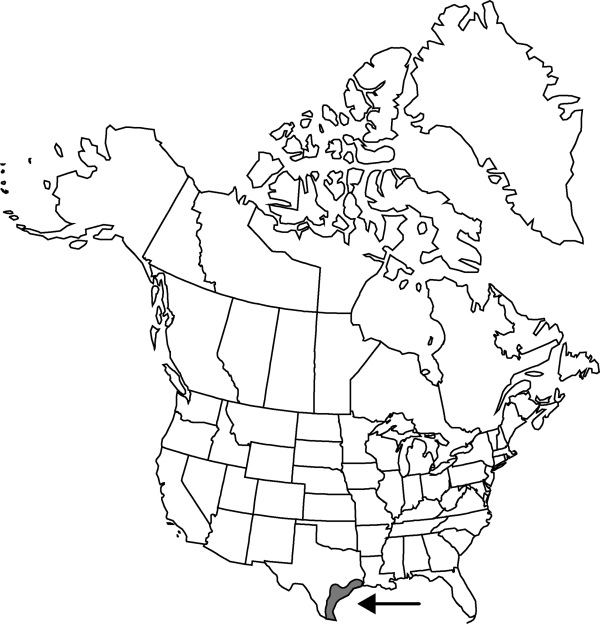Difference between revisions of "Atriplex matamorensis"
Proc. Amer. Acad. Arts 9: 118. 1874, not Villars 1779.
FNA>Volume Importer |
imported>Volume Importer |
||
| (6 intermediate revisions by 2 users not shown) | |||
| Line 23: | Line 23: | ||
|elevation=0-50 m | |elevation=0-50 m | ||
|distribution=Tex.;Mexico. | |distribution=Tex.;Mexico. | ||
| − | |discussion=<p>The quelite cenizo is a very distinctive, small, bushy perennial with numerous, ascending branches and tiny leaves. It is here tentatively placed adjacent to the other dioecious, herbaceous perennial, Atriplex watsonii, from which it differs in many ways (compare descriptions). Possibly its near relatives are in adjacent Mexico, which is beyond the consideration of the present paper; certainly it is one of the most distinctive of the herbaceous taxa. According to H. M. Hall and F. E. Clements (1923), the relationships of this species lie with A. watsonii, but it is more closely similar to A. elegans in the strongly compressed, nearly orbicular, and evenly dentate bracteoles. However, both A. watsonii and A. matamorensis have opposite leaves and share the feature of the pericarp being dilated around the thickened stigma bases.</p> | + | |discussion=<p>The quelite cenizo is a very distinctive, small, bushy perennial with numerous, ascending branches and tiny leaves. It is here tentatively placed adjacent to the other dioecious, herbaceous perennial, <i>Atriplex watsonii</i>, from which it differs in many ways (compare descriptions). Possibly its near relatives are in adjacent Mexico, which is beyond the consideration of the present paper; certainly it is one of the most distinctive of the herbaceous taxa. According to H. M. Hall and F. E. Clements (1923), the relationships of this species lie with <i>A. watsonii</i>, but it is more closely similar to <i>A. elegans</i> in the strongly compressed, nearly orbicular, and evenly dentate bracteoles. However, both <i>A. watsonii</i> and <i>A. matamorensis</i> have opposite leaves and share the feature of the pericarp being dilated around the thickened stigma bases.</p> |
|tables= | |tables= | ||
|references= | |references= | ||
| Line 32: | Line 32: | ||
-->{{#Taxon: | -->{{#Taxon: | ||
name=Atriplex matamorensis | name=Atriplex matamorensis | ||
| − | |||
|authority=A. Nelson | |authority=A. Nelson | ||
|rank=species | |rank=species | ||
| Line 47: | Line 46: | ||
|publication year=1779 | |publication year=1779 | ||
|special status= | |special status= | ||
| − | |source xml=https:// | + | |source xml=https://bitbucket.org/aafc-mbb/fna-data-curation/src/2e0870ddd59836b60bcf96646a41e87ea5a5943a/coarse_grained_fna_xml/V4/V4_721.xml |
|genus=Atriplex | |genus=Atriplex | ||
|subgenus=Atriplex subg. Obione | |subgenus=Atriplex subg. Obione | ||
Latest revision as of 22:00, 5 November 2020
Herbs, dioecious, from woody taproot, erect or ascending, branching at base, sparsely branched distally or simple, 1–4 dm, woody at base somewhat scurfy. Stems terete, slender, densely leafy, rather sparsely and closely scurfy. Leaves possibly Kranz type (difficult to determine), mostly opposite; blade oblong or oblong-lanceolate, 2–5 mm, subequal to internodes, broadest at middle, apex acute, densely grayish scurfy. Pistillate flowers solitary or in small, axillary glomerules in stout leafy spikes. Fruiting bracteoles sessile, suborbiculate, strongly compressed, 2–3 mm and broad, united to beyond middle, dentate to near base, triangular teeth acute, terminal 1 longest, faces 3-veined, scurfy. Seeds yellowish, 1 mm wide.
Phenology: Flowering summer and fall.
Habitat: Saline soils, coastal areas, often along roadsides, other disturbed areas
Elevation: 0-50 m
Discussion
The quelite cenizo is a very distinctive, small, bushy perennial with numerous, ascending branches and tiny leaves. It is here tentatively placed adjacent to the other dioecious, herbaceous perennial, Atriplex watsonii, from which it differs in many ways (compare descriptions). Possibly its near relatives are in adjacent Mexico, which is beyond the consideration of the present paper; certainly it is one of the most distinctive of the herbaceous taxa. According to H. M. Hall and F. E. Clements (1923), the relationships of this species lie with A. watsonii, but it is more closely similar to A. elegans in the strongly compressed, nearly orbicular, and evenly dentate bracteoles. However, both A. watsonii and A. matamorensis have opposite leaves and share the feature of the pericarp being dilated around the thickened stigma bases.
Selected References
None.
